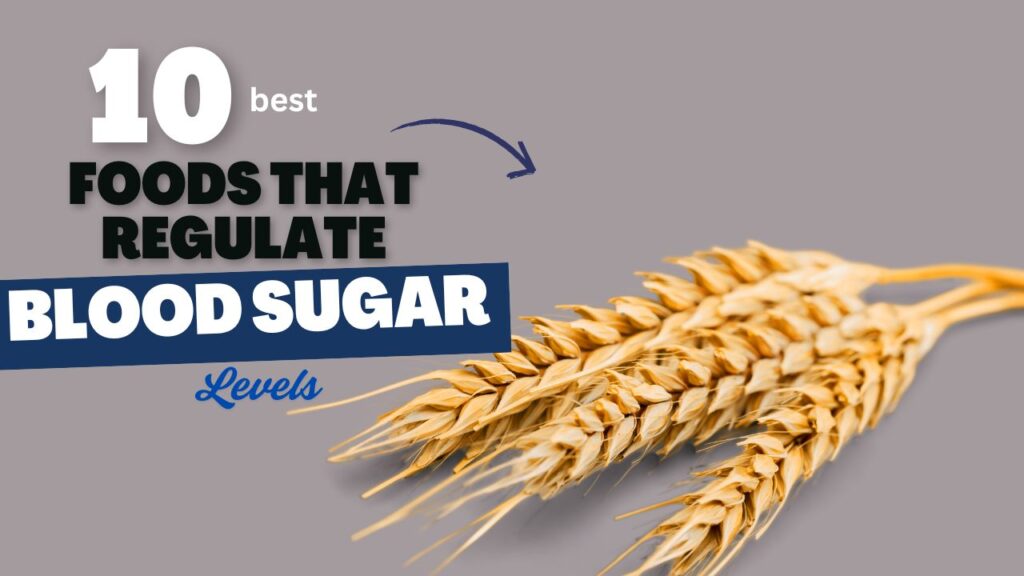Some links in this post are affiliate links. If you make a purchase through these links, I may receive a small commission. This helps support the site at no extra cost to you.
Struggling with unpredictable energy spikes or sugar cravings? You’re not alone. Millions of people worldwide face challenges managing their blood sugar, which can lead to fatigue, mood swings, and long-term health issues like diabetes.
But here’s some good news: what you eat plays a crucial role in stabilizing your blood sugar levels naturally.
Do you know that incorporating certain foods into your diet can help regulate blood sugar while also boosting overall health?
From leafy greens to protein-packed nuts, these natural options work with your body to maintain steady energy throughout the day.
In this post, we’ll dive deep into 10 foods that are proven to regulate blood sugar, explore the best ways to eat them, highlight who should and shouldn’t consume them, and share tips on buying, storing, and enjoying these foods safely.

Table of Contents

10 Foods To Regulate Blood Sugar
1. Leafy Greens (Spinach, Kale, Swiss Chard)
Leafy greens are not only low in calories but also rich in fiber and magnesium, which help improve insulin sensitivity. They are a staple for anyone aiming to maintain stable blood sugar levels.
Best Ways to Eat or Use It
- Raw: Add spinach or kale to salads.
- Cooked: Lightly sauté with olive oil to retain nutrients.
- Smoothies: Blend with fruits like berries for a nutrient-packed breakfast.
Tips: Pair leafy greens with healthy fats, like avocado or olive oil, to enhance absorption of fat-soluble vitamins.
Who Should Eat / Avoid
- Good for: Diabetics, weight-loss seekers, pregnant women.
- Avoid/Limit if: You have kidney issues that require limiting high-oxalate foods.
Storage & Buying Tips
- Choose bright green leaves with firm stems.
- Store in a perforated bag in the fridge to extend freshness.
Do’s & Don’ts
| ✅ Do | ❌ Don’t |
|---|---|
| Eat fresh or lightly cooked | Overcook and lose nutrients |
| Combine with healthy fats | Store in damp, sealed containers |
Possible Side Effects
- Excessive consumption may contribute to kidney stones in susceptible individuals.
2. Berries (Blueberries, Strawberries, Raspberries)
Berries are loaded with antioxidants and fiber, which slow down sugar absorption and prevent blood sugar spikes.
Best Ways to Eat or Use It
- Fresh: Snack on a handful during the day.
- Smoothies: Blend with Greek yogurt for a balanced meal.
- Toppings: Add to oatmeal, cereal, or salads.
Tips: Pair berries with protein sources like nuts or yogurt to further regulate blood sugar.
Who Should Eat / Avoid
- Good for: People managing diabetes, athletes, anyone needing antioxidants.
- Avoid/Limit if: Allergic to certain fruits.
Storage & Buying Tips
- Look for firm, plump berries without mold.
- Refrigerate and consume within 2–3 days or freeze for longer storage.
Do’s & Don’ts
| ✅ Do | ❌ Don’t |
|---|---|
| Wash just before eating | Leave wet berries in fridge too long |
| Mix with protein | Eat excessive amounts in one sitting |
Possible Side Effects
- Large quantities may cause digestive discomfort due to high fiber content.
3. Cinnamon
Cinnamon is a spice that can mimic insulin and improve glucose uptake by cells.
Best Ways to Eat or Use It
- Sprinkle on oatmeal, yogurt, or coffee.
- Mix into baked goods for natural sweetness without sugar.
Tips: Ceylon cinnamon is preferred over cassia for long-term consumption due to lower coumarin content.
Who Should Eat / Avoid
- Good for: Pre-diabetics, those wanting to reduce sugar intake.
- Avoid/Limit if: Taking blood-thinning medications.
Storage & Buying Tips
- Store in a cool, dark place in an airtight container.
Do’s & Don’ts
| ✅ Do | ❌ Don’t |
|---|---|
| Use daily in moderation | Take large supplements without consulting a doctor |
Possible Side Effects
- Excessive intake may lead to liver issues in sensitive individuals.
4. Whole Grains (Oats, Quinoa, Barley)
Whole grains contain fiber and complex carbohydrates, which slow sugar absorption and prevent spikes.
Best Ways to Eat or Use It
- Breakfast: Cook oatmeal or quinoa porridge.
- Lunch/Dinner: Replace white rice with barley or brown rice.
- Snacks: Whole-grain crackers or granola.
Tips: Avoid heavily processed grains to maximize benefits.
Who Should Eat / Avoid
- Good for: Diabetics, athletes, anyone wanting sustained energy.
- Avoid/Limit if: Gluten-sensitive (choose gluten-free grains like quinoa).
Storage & Buying Tips
- Choose whole, unprocessed grains.
- Store in airtight containers to prevent moisture and pests.
Do’s & Don’ts
| ✅ Do | ❌ Don’t |
|---|---|
| Cook and eat in moderation | Rely on refined grains |
| Combine with protein | Overcook and lose fiber |
Possible Side Effects
- Overconsumption can cause bloating or gas due to fiber.
5. Nuts (Almonds, Walnuts, Pistachios)
Nuts are high in healthy fats, protein, and fiber, helping stabilize blood sugar and reduce cravings.
Best Ways to Eat or Use It
- Snacks: Handful of raw or roasted nuts.
- Toppings: Add to salads, oatmeal, or smoothies.
Tips: Avoid salted or sugar-coated nuts to prevent blood sugar spikes.
Who Should Eat / Avoid
- Good for: Weight-management, diabetics, anyone needing heart-healthy fats.
- Avoid/Limit if: Allergic to nuts.
Storage & Buying Tips
- Store in airtight containers or the fridge to prevent rancidity.
Do’s & Don’ts
| ✅ Do | ❌ Don’t |
|---|---|
| Eat in moderation | Consume flavored nuts with added sugar |
| Pair with fruits or yogurt | Overeat in one sitting |
Possible Side Effects
- Can be high in calories if eaten excessively.
6. Legumes (Lentils, Chickpeas, Black Beans)
Legumes are rich in fiber and protein, making them excellent for blood sugar regulation.
Best Ways to Eat or Use It
- Soups & Stews: Add cooked lentils or beans.
- Salads: Mix chickpeas with fresh vegetables.
- Snacks: Roasted chickpeas as crunchy treats.
Tips: Soaking and cooking properly reduces anti-nutrients and improves digestibility.
Who Should Eat / Avoid
- Good for: Vegetarians, diabetics, athletes.
- Avoid/Limit if: Prone to digestive issues or gas.
Storage & Buying Tips
- Buy dry beans for longer shelf life.
- Cooked beans can be stored in the fridge for up to 5 days.
Do’s & Don’ts
| ✅ Do | ❌ Don’t |
|---|---|
| Cook thoroughly | Eat raw legumes |
| Pair with spices to aid digestion | Overconsume at once |
Possible Side Effects
- Can cause gas or bloating if not prepared properly.
7. Fatty Fish (Salmon, Mackerel, Sardines)
Omega-3 fatty acids in fatty fish improve insulin sensitivity and reduce inflammation, which is crucial for blood sugar control.
Best Ways to Eat or Use It
- Grilled or baked: Maintain nutrients.
- Salads: Flake cooked fish into green salads.
- Snacks: Smoked salmon on whole-grain crackers.
Tips: Pair with vitamin C-rich foods like lemon for better nutrient absorption.
Who Should Eat / Avoid
- Good for: Heart health, diabetics, anyone needing protein and omega-3s.
- Avoid/Limit if: Allergic to fish or have high mercury concerns.
Storage & Buying Tips
- Choose fresh or frozen fish with firm flesh and no fishy odor.
Do’s & Don’ts
| ✅ Do | ❌ Don’t |
|---|---|
| Cook lightly to preserve omega-3s | Fry in unhealthy oils |
| Eat 2–3 times per week | Consume high-mercury fish too often |
Possible Side Effects
- Overconsumption of certain fish may lead to mercury exposure.
8. Greek Yogurt
Greek yogurt is packed with protein and probiotics, helping regulate blood sugar and improve gut health.
Best Ways to Eat or Use It
- Breakfast: With berries and nuts.
- Smoothies: Blend with fruits for creamy texture.
- Snacks: Plain Greek yogurt with a drizzle of honey.
Tips: Choose plain, unsweetened versions for maximum benefit.
Who Should Eat / Avoid
- Good for: Diabetics, weight-loss seekers, gut health enthusiasts.
- Avoid/Limit if: Lactose intolerant or allergic to dairy.
Storage & Buying Tips
- Keep refrigerated and check expiration dates.
- Consume within 5–7 days after opening.
Do’s & Don’ts
| ✅ Do | ❌ Don’t |
|---|---|
| Pair with fruit or nuts | Choose flavored, sugar-laden versions |
| Eat daily in moderation | Overconsume in one sitting |
Possible Side Effects
- May cause digestive issues for lactose-sensitive individuals.
9. Avocado
Avocados are rich in healthy monounsaturated fats, which slow digestion and prevent blood sugar spikes.
Best Ways to Eat or Use It
- Salads: Dice into leafy greens.
- Smoothies: Add for creamy texture.
- Spreads: Mash on whole-grain toast.
Tips: Pair with citrus for enhanced vitamin C absorption.
Who Should Eat / Avoid
- Good for: Diabetics, heart health, weight management.
- Avoid/Limit if: Allergic to avocado.
Storage & Buying Tips
- Choose slightly firm avocados for ripening.
- Store ripe ones in the fridge for up to 3 days.
Do’s & Don’ts
| ✅ Do | ❌ Don’t |
|---|---|
| Eat with fiber-rich foods | Fry in excessive oil |
| Include in meals | Overconsume large amounts |
Possible Side Effects
- Overeating may contribute to high calorie intake.
10. Apple Cider Vinegar
Apple cider vinegar can improve insulin sensitivity and slow carbohydrate digestion.
Best Ways to Eat or Use It
- Dilute in water: Drink before meals.
- Salad dressing: Mix with olive oil.
- Marinades: Use for meats and vegetables.
Tips: Always dilute to protect teeth and stomach lining.
Who Should Eat / Avoid
- Good for: Pre-diabetics, diabetics, weight-management.
- Avoid/Limit if: Stomach ulcers or acid reflux.
Storage & Buying Tips
- Choose raw, unfiltered vinegar with the “mother.”
- Store in a cool, dark place.
Do’s & Don’ts
| ✅ Do | ❌ Don’t |
|---|---|
| Dilute before drinking | Consume undiluted |
| Use regularly in meals | Overuse excessively |
Possible Side Effects
- May cause digestive discomfort if taken in excess.
Conclusion
Incorporating these 10 foods that regulate blood sugar into your daily meals can help maintain steady energy, reduce cravings, and improve overall health.
From fiber-rich leafy greens to healthy fats in avocados and protein-packed Greek yogurt, these foods are simple, versatile, and effective.
Start small—maybe add berries to your breakfast, include legumes in your lunch, or enjoy avocado toast in the evening. Over time, these choices can make a significant impact on your blood sugar and overall well-being.
Share your favorite recipe using any of these foods in the comments and inspire others to enjoy delicious, blood sugar-friendly meals!
Frequently Asked Questions (FAQs)
Can these foods completely replace diabetes medication?
No, while these foods can help regulate blood sugar naturally, they are not a replacement for prescribed medication. Always consult your doctor before making any changes to your treatment plan.
How often should I eat these foods to see results?
Incorporating them daily or several times a week can help stabilize blood sugar over time. Consistency is key, combined with a balanced diet and regular exercise.
Are there any foods that spike blood sugar that I should avoid?
Yes, foods high in refined sugar and processed carbs, such as pastries, sugary drinks, and white bread, can cause rapid blood sugar spikes.
Can children benefit from these foods too?
Absolutely! Most of these foods, like berries, leafy greens, and whole grains, are safe for children and help maintain balanced energy levels.
Is it okay to combine multiple blood sugar-regulating foods in one meal?
Yes, combining foods like leafy greens, nuts, and fatty fish in one meal can enhance blood sugar control. Pairing fiber with protein or healthy fats is especially effective.
How do I know which food works best for me?
Individual responses vary. Monitoring blood sugar levels before and after meals can help identify which foods have the most stabilizing effect for your body.
Can I eat these foods if I’m pregnant?
Most are safe and beneficial during pregnancy, like leafy greens, berries, and legumes. However, consult your healthcare provider regarding portion sizes and any specific restrictions.
Do these foods help with weight loss too?
Yes, many of these foods are high in fiber and protein, which can promote satiety and reduce overeating, supporting healthy weight management.
Are supplements as effective as these natural foods?
Supplements can help in some cases, but whole foods provide a combination of fiber, vitamins, minerals, and antioxidants that work synergistically to regulate blood sugar.
Can I store these foods long-term without losing their benefits?
Some, like leafy greens or berries, are best consumed fresh or frozen, while grains, nuts, and cinnamon have longer shelf lives if stored properly.










